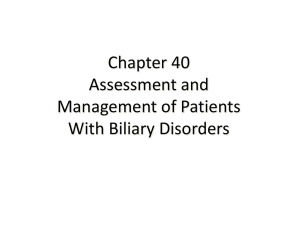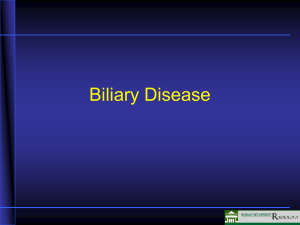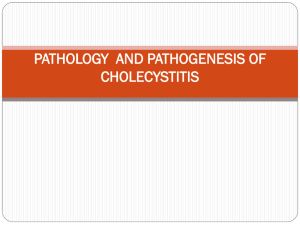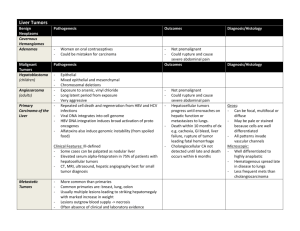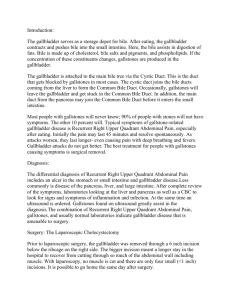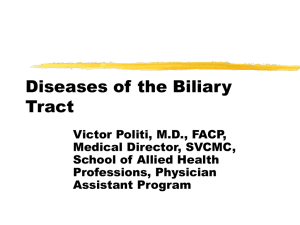Path Chapter 18 p882-889 [4-20
advertisement
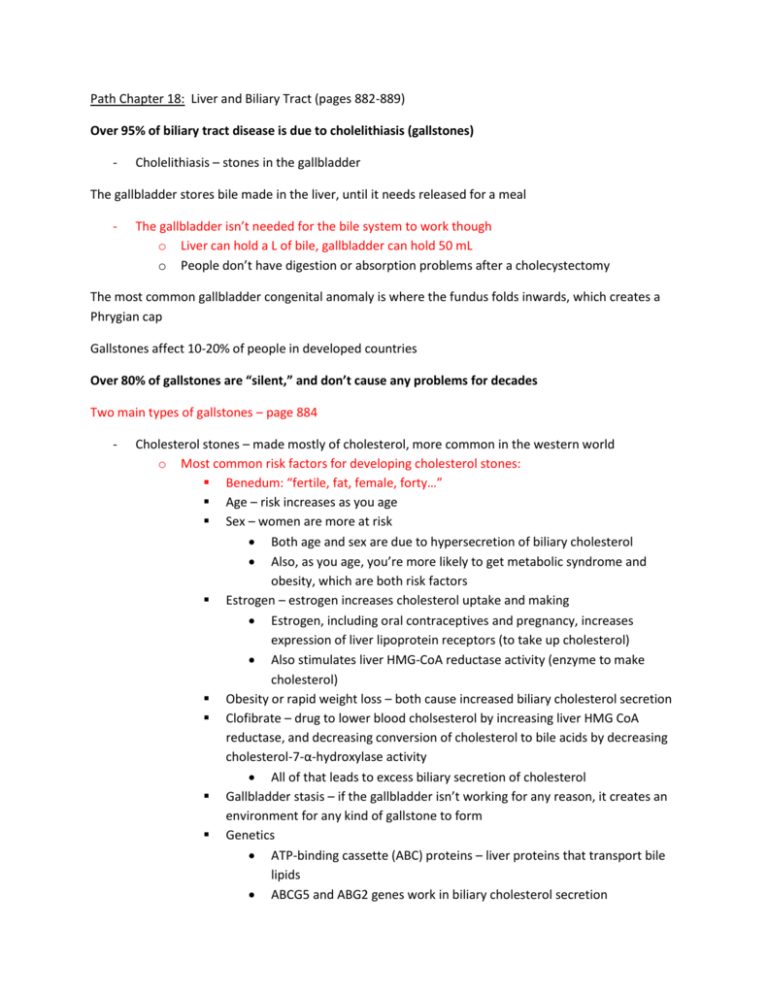
Path Chapter 18: Liver and Biliary Tract (pages 882-889) Over 95% of biliary tract disease is due to cholelithiasis (gallstones) - Cholelithiasis – stones in the gallbladder The gallbladder stores bile made in the liver, until it needs released for a meal - The gallbladder isn’t needed for the bile system to work though o Liver can hold a L of bile, gallbladder can hold 50 mL o People don’t have digestion or absorption problems after a cholecystectomy The most common gallbladder congenital anomaly is where the fundus folds inwards, which creates a Phrygian cap Gallstones affect 10-20% of people in developed countries Over 80% of gallstones are “silent,” and don’t cause any problems for decades Two main types of gallstones – page 884 - Cholesterol stones – made mostly of cholesterol, more common in the western world o Most common risk factors for developing cholesterol stones: Benedum: “fertile, fat, female, forty…” Age – risk increases as you age Sex – women are more at risk Both age and sex are due to hypersecretion of biliary cholesterol Also, as you age, you’re more likely to get metabolic syndrome and obesity, which are both risk factors Estrogen – estrogen increases cholesterol uptake and making Estrogen, including oral contraceptives and pregnancy, increases expression of liver lipoprotein receptors (to take up cholesterol) Also stimulates liver HMG-CoA reductase activity (enzyme to make cholesterol) Obesity or rapid weight loss – both cause increased biliary cholesterol secretion Clofibrate – drug to lower blood cholsesterol by increasing liver HMG CoA reductase, and decreasing conversion of cholesterol to bile acids by decreasing cholesterol-7-α-hydroxylase activity All of that leads to excess biliary secretion of cholesterol Gallbladder stasis – if the gallbladder isn’t working for any reason, it creates an environment for any kind of gallstone to form Genetics ATP-binding cassette (ABC) proteins – liver proteins that transport bile lipids ABCG5 and ABG2 genes work in biliary cholesterol secretion o - The mutant form is called D19H, and can cause cholesterol gallstones to form D19H causes you to absorb less, but make more cholesterol o Cholesterol is made soluble in bile by aggregating it with water-soluble bile salts, and water-insoluble lecithins (they both act as detergents) o When cholesterol concentrations are supersaturated, the cholesterol starts to clump into solid cholesterol monohydrate crystals o For cholesterol gallstones to form, you need 4 simultaneous conditions: The bile is supersaturated with cholesterol There is less movement than normal in or by the gallbladder Cholesterol nucleation (clumping) is accelerated Hypersecretion of mucus in the gallbladder traps the clumped cholesterol, leading to their consolidation into stones o Morphology of cholesterol stones: Cholesterol stones are only found in the gallbladder Cholesterol stones appear pale yellow, round, and have granular, hard surfaces The more calcium carbonate, phosphates, and bilirubin there is though, the more the stone is discolored to gray or black Cholesterol stones are radiolucent Pigment stones – made mostly of unconjugated bilirubin mixed with calcium salts, more common in Asians o Unconjugated bilirubin is usually a minor part of the bile o Anything that causes increased amounts of unconjugated bilirubin in bile will increase the risk of developing pigment stones Includes hemolytic syndromes, severe ileal dysfunction or bypass, and bacterial infection of the bile tree Hemolytic syndromes increase the secretion of conjugated bilirubin into the bile 1% of conjugated bilirubin gets unconjugated while in the bile tree, so if there’s more conj. Bilirubin secretion, more unconjugated bilirubin piles up, which can exceed its solubility o Pigment stones are most often caused by bacterial infections of the bile tree, or parasites Infection of the bile tree causes the microbe to release β-glucuronidases to unconjugated the bilirubin o Pigment stones can be classified as “black” or “brown” Black pigment stones – usually found when there is no infection Black pigment stones have oxidized calcium salts of unconjugated bilirubin, and a little calcium carbonate, calcium phosphate, mucin, and cholesterol Calcium carbonate makes 50-75% of black stones radiopaque - Brown pigment stones – usually found when there is an infection present Brown pigment stones have pure calcium salts of unconjugated bilirubin, mucin, a decent amount of cholesterol, and fats Brown stones have calcium soaps, making them radiolucent Mucin acts as the cement holding gallstones together Gallstones can be present for decades before symptoms show up, and most never develop symptoms – we all most likely have some stones Gallstones cause a pain called “biliary pain,” which is excruciating and constant or “colicky” (spasmodic) – biliary colic Gallstones can cause inflammation of the bile tree (cholangitis) or gallbladder (cholecystitis), obstructive cholestasis, and pancreatitis The bigger the gallstone, the less likely it will enter the bile ducts and obstruct o The small stones fit into the ducts easily, and are more dangerous Gallstone ileus (aka Bouveret’s syndrome) – when the gallstone erodes into adjacent parts of the GI Gallstones increase the risk for cancer (carcinoma) of the gallbladder Cholecystitis – inflammation of the gallbladder - Cholecystitis almost always happens in association with gallstones (90% of the time) Cholecystitis can be acute, chronic, or both Acute cholecystitis – acute inflammation and irritation of an obstructed gallbladder o 90% of the time it’s caused by an obstruction of the cystic duct or neck of the gallbladder o Acute cholecystitis is the main complication of gallstones, and the most common reason for an emergency cholecystectomy (gallbladder removal) o The irritation disrupts the glycoprotein mucus layer that normally protects This exposes the mucosal epithelium to the detergent action of bile salts Prostaglandins are released from the gallbladder wall and add to the inflammation o This leads to gallbladder dysmotility – distention and increased intraluminal pressure block blood flow to the mucosa o At this point, infection can take place and lead to more and worse symptoms o Acute acalculous (no stones) cholecystitis is thought to result from ischemia Rare, happens only 10% of the time The cystic artery is an end artery with no collateral circulation Inflammation and edema can compromise blood flow Cholesterol, bile, and mucus can accumulate and block flow as well Risk factors for acute acalculous cholecystitis are sepsis with hypotension and multisystem organ failure, immunosuppression, trauma, burns, diabetes, and infections o Morphology of acute cholecystitis: - The gallbladder is usually enlarged The gallbladder may look bright red, or blotchy purple to green-black A fibrin layer usually coats the serosa, and severe cases include a suppurative coagulated exudate Only difference between calculous and acalculous is whether a stone is there or not Empyema of the gallbladder – when the exudate in the gallbladder is pretty much pure pus, as opposed to a mix of bile, pus, fibrin, and blood like usual In mild acute cholecystitis, the gallbladder wall is thickened, edematous, and hyperemic (blood engorged) In severe acute cholecystitis, the gallbladder becomes a green-black necrotic organ – called gangrenous cholecystitis o An attack of acute cholecystitis starts with right upper quadrant or epigastric pain Usually includes mild fever, lack of appetite, tachycardia, nausea, vomiting, and sweating (red – benedum asked us about) If there is also hyperbilirubinemia (seen as jaundice), it means the common bile duct is obstructed Acute cholecystitis may also show leukocytosis (increased WBCs) and mildly increased alkaline phosphatase Acute cholecystitis can show up as sudden intense pain and be an emergency for treatment, or with mild symptoms that don’t need any medical help For those who recover without medical help, most have recurrences, and ¼ have symptoms get worse in future attacks The longer you wait to treat, the greater the chances of gangrene or perforation, leading to death Acalculous has a higher risk for these two Rarely, infections or atherosclerosis can cause acalculous cholecystitis Chronic cholecystitis o Can either be a product of repeated bouts of acute cholecystitis, or can develop with no previous attacks o 90% of the time, chronic cholecystitis involves gallstones (cholelithiasis) o Supersaturation of bile causes both the inflammation, and creates the environment for stones to form So supersaturation of bile is the cause of the cholecystitis o 1/3 the time, chronic cholecystitis includes infections by E. coli or enterococci o Unlike acute calculous cholecystitis, obstruction of gallbladder outflow isn’t required o Symptoms of chronic cholecystitis are similar to acute Includes anywhere from biliary colic pain, to right upper or epigastric pain o Morphology of chronic cholecystitis: May show signs of remaining fibrin from preexisting acute inflammation The gallbladder wall is thickened and opaque gray-white - Outpouchings of the mucosal epithelium through the gallbladder wall are called Rokitansky-Aschoff sinuses, and may be seen If you see dystrophic calcification, it’s called porcelain gallbladder, and increases the risk for cancer Xanthogranulomatous cholecystitis – hugely thick gallbladder wall, but gallbladder is shrunk with chronic inflammation, necrosis, and hemorrhage Hydrops of the gallbladder – atrophy and chronic inflammation of obstructed gallbladders cause only a clear secretion o Chronic cholecystitis isn’t as obvious as acute Usually characterized by recurrent attacks of either steady or colicky epigastric or right upper quadrant pain Often also sea nausea, vomiting, and intolerance for fatty foods Need to diagnose cholecystitis quick because these things could happen: o Infection o Gallbladder perforation o Gallbladder ruptures and causes peritonitis o A fistula forms that drains bile into organs, lets in air and bacteria into the bile tree, and can cause a gallstone-caused intestinal obstruction (ileus) Choledocholithiasis – stones in the bile ducts of the bile tree - More common in Asians Bile duct stones are usually pigmented, and cause bile tract infections Choledocholithiasis can be asymptomatic, or show symptoms from obstruction, pancreatitis, cholangitis, liver abscess, biliary cirrhosis, and acute calculous cholecystitis Cholangitis – bacterial infection of the bile ducts - Cholangitis can happen from any lesion that obstructs bile flow (most often by choledocholithiasis) Ascending cholangitis – infection of intrahepatic biliary radicles The infecting organism is usually enteric gram negatives like E. coli, klebsiella, enterococcus, or enterobacter Symptoms of cholangitis are fever, chills, abdominal pain, jaundice, and acute inflammation of the wall of the bile ducts and neutrophils in the lumen Suppurative cholangitis is the most severe form – purulent bile fills and distends the bile ducts Choledocholithiasis and cholangitis often happen together A major cause of neonatal cholestasis (bile flow out of liver is blocked) is biliary atresia - Biliary atresia – obstruction of the lumen of the extrahepatic bile tree within the first 3 months of life Biliary atresia is characterized by progressive inflammation and fibrosis of the bile ducts - - - Biliary atresia is the most common cause of death from liver disease in early childhood Two forms of biliary atresia, based on when the lumen is blocked: o Fetal biliary atresia - Bile tree doesn’t form right less common, and often includes other problems with organs forming o Perinatal biliary atresia – bile tree forms right, but then is destroyed after brith Much more common Thought to be caused by virus or autoimmunity Morphology of biliary atresia: o Shows inflammation and fibrosis causing constriction of the hepatic or common bile ducts o Also shows progressive inflammation and destruction of the bile tree o 2/3 of cases show features of biliary obstruction, like bile duct proliferation, portal tract edema and fibrosis, and cholestasis (bile backing up into the liver) o Cirrhosis will develop within 3-6 months if biliary atresia isn’t treated o Biliary atresia can be corrected by surgery (Kasai procedure) when it’s type 1 (limited to the common duct) or type 2 (in the liver bile ducts) 90% of patients though have type 3 biliary atresia (there’s also obstruction of bile ducts at or above the porta hepatis) which can’t be treated with surgery Treat biliary atresia with liver and bile duct transplants o w/o treatment, patient usually doesn’t make it two years choledochal cysts – rare congenital dilations of the common bile duct - Most often seen in kids younger than 10, and more often girls Choledochal cysts show jaundice and/or recurrent colic abdominal pain Can present as dilations int eh common bile duct, diverticuli of extrahepatic ducts, or choledochoceles (cysts that protrude into the duodenum’s lumen) Choledochal cysts predispose to stone formation, stenosis, pancreatitis, and obstructive problems Clinically important bile tract tumors are those that affect the epithelium lining the biliary tree - Adenomas – benign epithelial tumors Inflammatory polyps – mucosal projectioins with a surface stroma filled with inflammatory cells and lipid filled macrophage Carcinoma of the gallbladder is the most common cancer of the extrahepatic bile tract - Happens more often in women, and most often in your 70’s Gallbladder carcinoma is rarely able to be removed, and 5 year survival rate is low Gallstones are the most important risk factor for gallbladder carcinoma (involved in 95% of cases) o But only half a % of people with gallstones develop cancer after 20 years o The cancer is thought to come from the chronic inflammation from the gallstone - Gallbladder carcinomas have two patterns of growth: infiltrating and exophytic o Infiltrating – more common, penetrates the gallbladder wall o Exophytic – shows a cauliflower-like mass grow into the lumen and the wall o Most common site affected is the fundus or neck of the gallbladder o Most carcinomas fo the gallbladder are adenocacrinomas o Most gallbladder carcinomas have invaded the liver by the time they’re discovered o Shows abdominal pain, jaundice, anorexia, nausea, and vomiting

